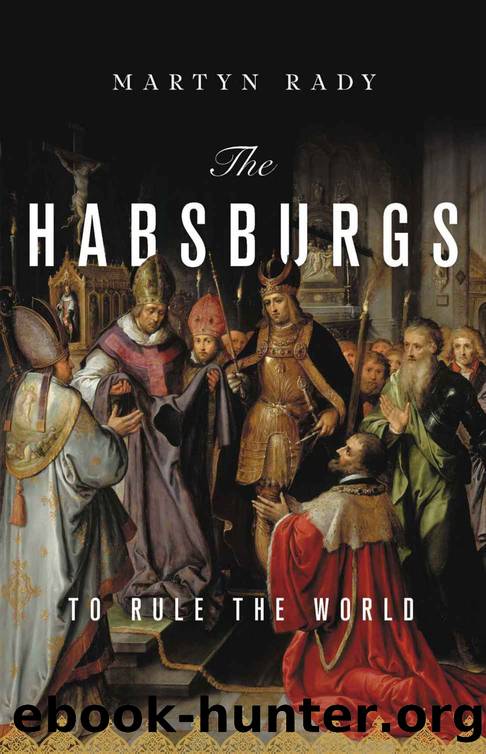The Habsburgs by Martyn C. Rady

Author:Martyn C. Rady [Rady, Martyn C.]
Language: eng
Format: azw3
Publisher: Basic Books
Published: 2020-08-25T00:00:00+00:00
19
VAMPIRISM, ENLIGHTENMENT, AND THE REVOLUTION FROM ABOVE
During the first half of the eighteenth century, vampires became a media sensation. Official reports documenting the popular belief in vampires in the part of Serbia recently occupied by the Habsburgs were leaked to news sheets and medical journals. The stories they told of the undead feasting on the living, of exhumed bodies oozing with the blood of victims, and of stakings and beheadings, were luridly reproduced and combined with older tales of shape-shifting and shroud-eating corpses. Voltaire in Paris later noted how âbetween 1730 and 1735 nothing was spoken of more than vampiresâhow they were hunted down, their hearts torn out, and their bodies burnt. They were like the martyrs of old; the more of them that were burnt, the more they found.â1
Reports of contagion spread from Serbia to Hungary and Transylvania. Unusual deaths or sightings, outbreaks of plague, and the discovery that a corpse had mummified rather than decomposed prompted copycat explanations and exhumations. There were plenty of educated authors who investigated the phenomena and found the evidence for vampirism to be lacking, but they often dressed up their otherwise measured accounts with sensationalist descriptions. Michael Ranft, whose sober treatise on whether corpses munched through their shrouds was first published in 1725, reworked his account a decade later to include a graphic account of the Serbian vampires, which he published in his compendious Treatise on the Chewing and Gnawing of the Dead in Their Graves, in Which Is Revealed the True Nature of the Hungarian Vampires and Bloodsuckers (Ranft thought Serbia to be in Hungary).2
Vampirism was reported in Moravia too. In 1755, with the agreement of the church authorities, the body of a woman was exhumed, decapitated, and burnt on the grounds that her corpse had been attacking villagers at night. This was the fourth time in three decades that the diocese of Olomouc had sanctioned exhumation, including in 1731 the disinterment of seven children, whose bodies had all been burnt. On news of this latest episode, Maria Theresa sent two doctors to investigate, but the terms of their commission left in no doubt what the empress expected of them. As she explained, it would be of âgreat service to mankindâ if their report could wean âcredulous peopleâ from their misbelief.3
The doctorsâ findings were submitted to Gerhard van Swieten, who made a summary which he subsequently published as a pamphlet. Van Swieten trebled up as Maria Theresaâs court librarian, personal physician, and censor. Thoroughly imbued with the spirit of rationalism, van Swieten rejected the supernatural for the same reason that he refused to wear a wig, since neither might be logically explained. Unsurprisingly, van Swieten found the Moravian case to be the product of error and rumour, akin to the conviction that black cats harboured devils or to the magical potions of conjurors. He wrote that on those occasions when corpses were found undecomposed, natural explanations might be found, most obviously that the weather was cold. Likewise, strange symptoms often proved to be the result of commonplace illnesses.
Download
This site does not store any files on its server. We only index and link to content provided by other sites. Please contact the content providers to delete copyright contents if any and email us, we'll remove relevant links or contents immediately.
| Africa | Americas |
| Arctic & Antarctica | Asia |
| Australia & Oceania | Europe |
| Middle East | Russia |
| United States | World |
| Ancient Civilizations | Military |
| Historical Study & Educational Resources |
Magic and Divination in Early Islam by Emilie Savage-Smith;(1501)
Ambition and Desire: The Dangerous Life of Josephine Bonaparte by Kate Williams(1346)
Bohemians, Bootleggers, Flappers, and Swells: The Best of Early Vanity Fair by Bohemians Bootleggers Flappers & Swells- The Best of Early Vanity Fair (epub)(1344)
Papillon by Henry Charrière(1311)
Twelve Caesars by Mary Beard(1258)
Operation Vengeance: The Astonishing Aerial Ambush That Changed World War II by Dan Hampton(1137)
What Really Happened: The Death of Hitler by Robert J. Hutchinson(1131)
London in the Twentieth Century by Jerry White(1114)
Time of the Magicians by Wolfram Eilenberger(1089)
The Japanese by Christopher Harding(1086)
Twilight of the Gods by Ian W. Toll(1084)
Lenin: A Biography by Robert Service(1045)
The Devil You Know by Charles M. Blow(985)
A Social History of the Media by Peter Burke & Peter Burke(939)
Freemasons for Dummies by Hodapp Christopher;(923)
Napolean Hill Collection by Napoleon Hill(905)
Henry III by David Carpenter;(892)
The Churchill Complex by Ian Buruma(884)
The Rise and Triumph of the Modern Self by Unknown(880)
